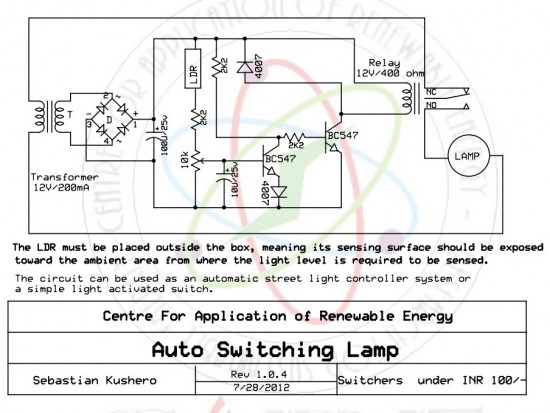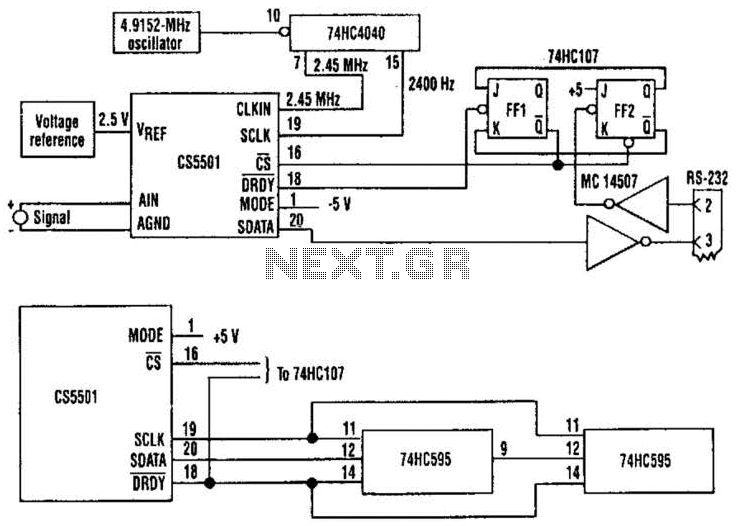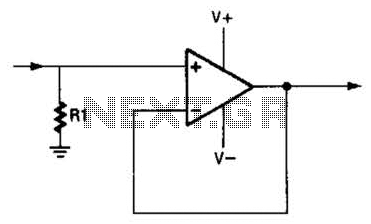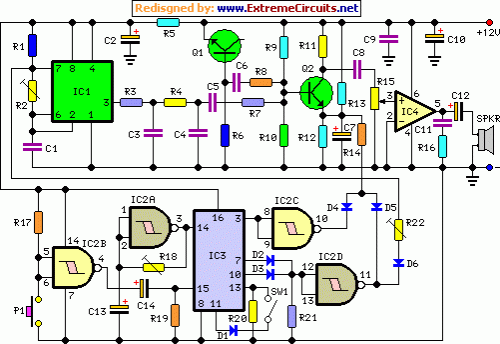
cars brake lights monitor circuit

The circuit described below monitors the car's brake lights and indicates their operational status using a 12V light-emitting diode (LED). This functionality can prevent fines for driving with defective brake lights and enhance road safety. The monitor relies on the voltage drop across the supply lines to the two lamps. For proper operation, this voltage drop must exceed 0.6V. If it does not, a 5V diode should be added in series with each lamp to increase the drop. Transistors T1 and T2 form a Schmitt trigger that responds to the voltage drop across the supply lines of the brake lights. This response activates the LED (D1) through transistor T3. If one brake light is faulty, the current draw from the functioning lamp will cause D1 to light briefly when the brake pedal is pressed. If both brake lights are defective, D1 will not light. The circuit can indicate all three potential states of the brake lights. The sensitivity of the circuit can be fine-tuned using potentiometer P1. It is recommended to adjust this preset with one lamp disconnected to achieve the desired brief illumination of D1. If the illumination of D1 during braking is undesirable, the operation can be inverted by replacing the BC557B transistor in the T3 position with a BC547B (NPN). In this case, the collector of T3 should be connected to the positive supply line, and the emitter to resistor R6. This change requires the flat edge of T3 to be oriented differently on the printed circuit board. Additionally, a second base connection is available on the PCB. However, this modified configuration does not allow for distinguishing whether one or both brake lights are faulty; when the LED lights up, it indicates that one or both lamps need replacement.
The circuit operates by monitoring the voltage levels across the brake light supply lines. When the brake pedal is pressed, the voltage drop across the lamps is detected by the Schmitt trigger formed by transistors T1 and T2. This configuration provides hysteresis, ensuring stable operation by preventing false triggering due to noise or minor fluctuations in voltage.
The LED (D1) serves as a visual indicator of the brake light status. When both brake lights are functional, the voltage drop is sufficient to keep the LED off. If one light fails, the remaining light will draw more current, causing the voltage drop to exceed the threshold, which activates D1 momentarily. If both lights are inoperative, the LED remains off, indicating a complete failure.
Adjusting the sensitivity of the circuit via potentiometer P1 allows for calibration based on the specific characteristics of the brake lights used. This feature is crucial for ensuring consistent performance across different vehicle models and lamp types.
In the alternative configuration with the BC547B transistor, the circuit's behavior changes, providing a simpler indication of a fault without differentiating between one or both lights being out. This modification may be preferable in applications where simplicity is desired over detailed diagnostics.
Overall, this circuit enhances vehicle safety by providing a straightforward method to monitor brake light functionality, allowing for timely maintenance and reducing the risk of accidents due to non-operational brake lights.The circuit described below monitors your car`s brake lights, and indicates by a light emiting diode 12V whether they both function correctly. In that sense, it can save you money by preventing your being fined for driving with defective brake lights, and it also leads to increasing road safety.
The monitor depends inevitably on the voltage drop a cross the supply lines to the two lamps. For the circuit to work correctly, that drop needs to be greater than 0. 6 V. If this is not so, the drop must be in- creased by adding a 5 V diode in series with each lamp. Transistor Ti and T2 in figure 1 form a Schmitt trigger, which reacts to the voltage drop across the supply lines to the two brake lights. This reaction manifests itself in Di lighting via T3. If one of the brake lights is faulty, the switch-on cur- rent drawn by the other lamp will cause Di to light briefly when the brake pedal is pressed.
If both brake lights are defective, Di will not light at all. All three possible states of the brake lights are thus indicated. sitivity of the circuit, can be adjusted within narrow limits with Pi. The preset is best adjusted with one lamp out of action in a manner which makes Di light briefly as described above. If you find it disturbing that Di lights every time you brake, the operation can be reversed by replacing the BC557B in the T3 position by a BC547B (n-p-n).
The collector of T3 is then connected to the positive supply line, and the emitter to R6. On the printed circuit board this means that the flat edge of T3 must be turned the other way. A second base connection has also been provided on the PCB. Note, however, that this configuration no longer makes it possible to ascertain whether one or both brake lights are faulty, i. e. , when the LED lights, one or both lamps need replacing. 🔗 External reference
The circuit operates by monitoring the voltage levels across the brake light supply lines. When the brake pedal is pressed, the voltage drop across the lamps is detected by the Schmitt trigger formed by transistors T1 and T2. This configuration provides hysteresis, ensuring stable operation by preventing false triggering due to noise or minor fluctuations in voltage.
The LED (D1) serves as a visual indicator of the brake light status. When both brake lights are functional, the voltage drop is sufficient to keep the LED off. If one light fails, the remaining light will draw more current, causing the voltage drop to exceed the threshold, which activates D1 momentarily. If both lights are inoperative, the LED remains off, indicating a complete failure.
Adjusting the sensitivity of the circuit via potentiometer P1 allows for calibration based on the specific characteristics of the brake lights used. This feature is crucial for ensuring consistent performance across different vehicle models and lamp types.
In the alternative configuration with the BC547B transistor, the circuit's behavior changes, providing a simpler indication of a fault without differentiating between one or both lights being out. This modification may be preferable in applications where simplicity is desired over detailed diagnostics.
Overall, this circuit enhances vehicle safety by providing a straightforward method to monitor brake light functionality, allowing for timely maintenance and reducing the risk of accidents due to non-operational brake lights.The circuit described below monitors your car`s brake lights, and indicates by a light emiting diode 12V whether they both function correctly. In that sense, it can save you money by preventing your being fined for driving with defective brake lights, and it also leads to increasing road safety.
The monitor depends inevitably on the voltage drop a cross the supply lines to the two lamps. For the circuit to work correctly, that drop needs to be greater than 0. 6 V. If this is not so, the drop must be in- creased by adding a 5 V diode in series with each lamp. Transistor Ti and T2 in figure 1 form a Schmitt trigger, which reacts to the voltage drop across the supply lines to the two brake lights. This reaction manifests itself in Di lighting via T3. If one of the brake lights is faulty, the switch-on cur- rent drawn by the other lamp will cause Di to light briefly when the brake pedal is pressed.
If both brake lights are defective, Di will not light at all. All three possible states of the brake lights are thus indicated. sitivity of the circuit, can be adjusted within narrow limits with Pi. The preset is best adjusted with one lamp out of action in a manner which makes Di light briefly as described above. If you find it disturbing that Di lights every time you brake, the operation can be reversed by replacing the BC557B in the T3 position by a BC547B (n-p-n).
The collector of T3 is then connected to the positive supply line, and the emitter to R6. On the printed circuit board this means that the flat edge of T3 must be turned the other way. A second base connection has also been provided on the PCB. Note, however, that this configuration no longer makes it possible to ascertain whether one or both brake lights are faulty, i. e. , when the LED lights, one or both lamps need replacing. 🔗 External reference





